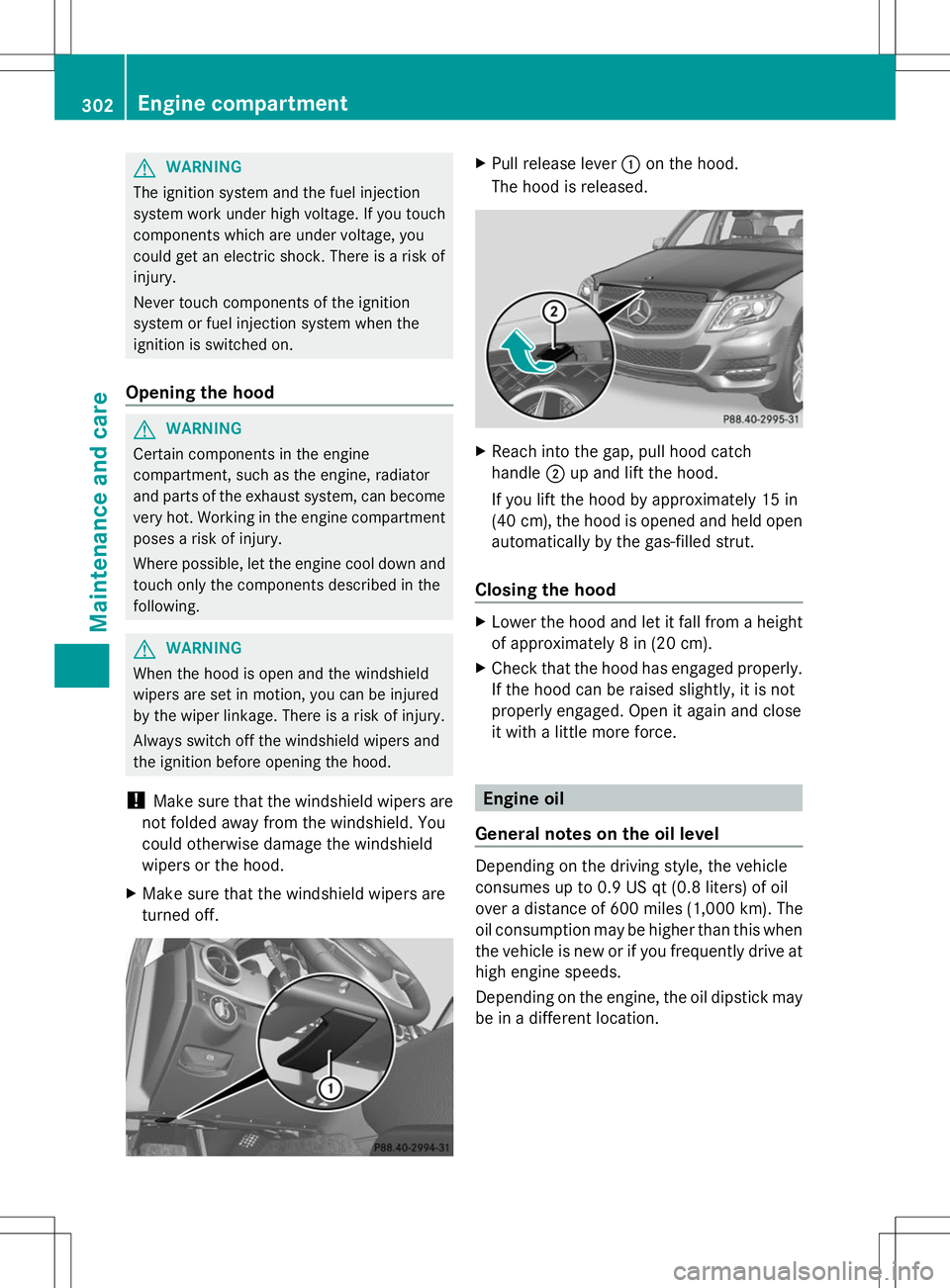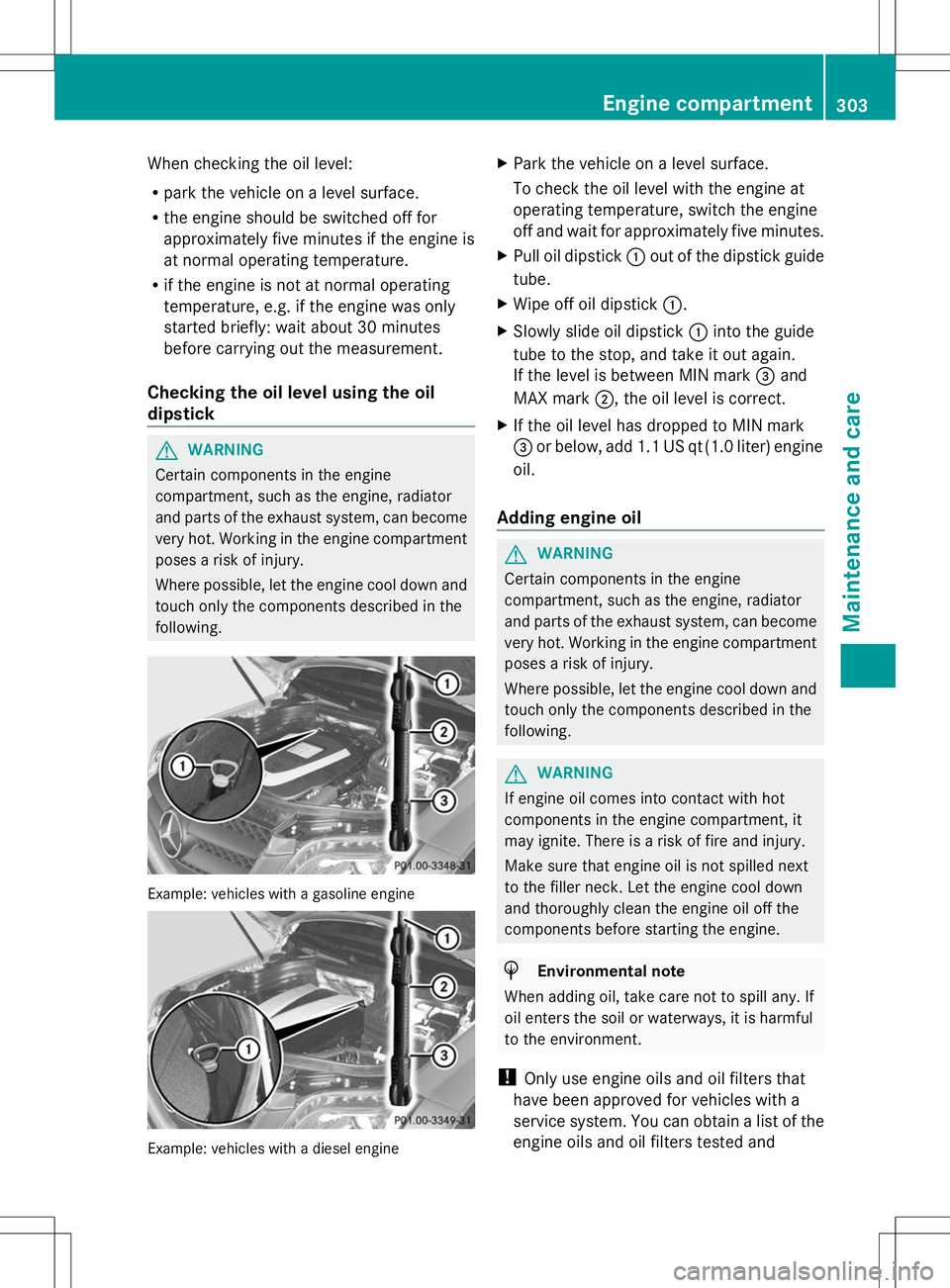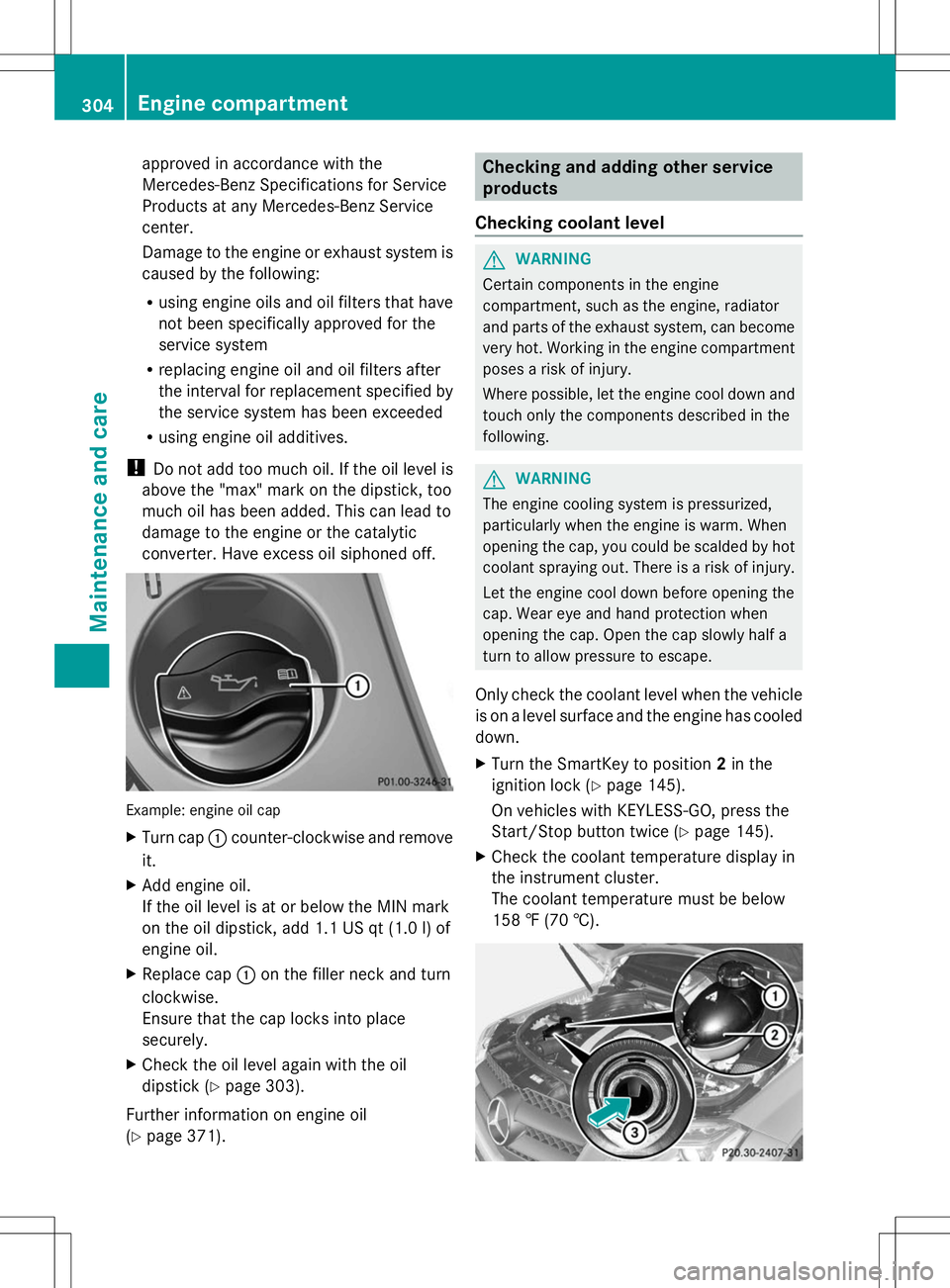2014 MERCEDES-BENZ GLK-CLASS SUV oil dipstick
[x] Cancel search: oil dipstickPage 12 of 384

Engine oil
Adding ........................................... 303
Additives ........................................ 372
Checking the oil level ..................... 302
Checking the oil level using the
dipstick .......................................... 303
Display message ............................ 249
Filling capacity ............................... 372
Notes about oil grades ................... 371
Notes on oil level/consumption ....302
Viscosity ........................................ 372
ESP ®
(Electronic Stability
Program) Deactivating/activating ...................70
Display message ............................ 236
ETS/4ETS ........................................ 70
Function/notes ......................... 69, 70
Important safety information ...........70
Trailer stabilization ........................... 71
Warning lamp ................................. 265
ETS/4ETS (Electronic Traction
System) ................................................ 70
Exhaust check ................................... 166
Exhaust tail pipe (cleaning
instructions) ...................................... 310
Exterior lighting Setting options .............................. 112
see Lights
Exterior mirrors
Adjusting ....................................... 106
Dipping (automatic) .......................107
Folding in/out (automatically). ......107
Folding in/out (electrically). ..........107
Folding in when locking (on-board
computer) ...................................... 234
Out of position (troubleshooting) ...107
Setting ........................................... 107
Storing settings (memory function) 109
Storing the parking position ..........108 F
Filler cap see Fuel filler flap
First-aid kit ......................................... 314 Flat tire
MOExtended run-flat system .........315
Preparing the vehicle .....................314
see Emergency spare wheel
Floormats ........................................... 298
Fog lamps Switching on/off ........................... 113
Folding the rear bench seat
forwards/back .................................. 276
Fording Off-road ......................................... 170
On flooded roads ........................... 170
Front fog lamps
Display message ............................ 245
Switching on/off ........................... 113
Fuel
Additives ........................................ 369
Consumption statistics ..................223
Displaying the current
consumption .................................. 224
Displaying the range ......................224
Driving tips .................................... 166
Fuel gauge ....................................... 33
Grade (gasoline) ............................ 369
Important safety notes ..................368
Premium-grade unleaded gasoline .369
Problem (malfunction) ...................161
Quality (diesel )............................... 370
Refueling ........................................ 158
Tank content/reserve fuel .............368
Fuel filler flap
Opening/closing ............................ 159
Fuel filter (display message) ............250
Fuel level Calling up the range (on-board
computer) ...................................... 224
Fuel tank
Capacity ........................................ 368
Problem (malfunction) ...................161
Fuse allocation chart (vehicle tool
kit) ...................................................... 314
Fuses Allocation chart ............................. 325
Before changing ............................. 325
Dashboard fuse box .......................325
Fuse box in the cargo
compartment ................................. 32610
Index
Page 304 of 384

G
WARNING
The ignition system and the fuel injection
system work under high voltage. If you touch
components which are under voltage, you
could get an electric shock. There is a risk of
injury.
Never touch components of the ignition
system or fuel injection system when the
ignition is switched on.
Opening the hood G
WARNING
Certain components in the engine
compartment, such as the engine, radiator
and parts of the exhaust system, can become
very hot. Working in the engine compartment
poses a risk of injury.
Where possible, let the engine cool down and
touch only the components described in the
following. G
WARNING
When the hood is open and the windshield
wipers are set in motion, you can be injured
by the wiper linkage. There is a risk of injury.
Always switch off the windshield wipers and
the ignition before opening the hood.
! Make sure that the windshield wipers are
not folded away from the windshield. You
could otherwise damage the windshield
wipers or the hood.
X Make sure that the windshield wipers are
turned off. X
Pull release lever :on the hood.
The hood is released. X
Reach into the gap, pull hood catch
handle ;up and lift the hood.
If you lift the hood by approximately 15 in
(40 cm), the hood is opened and held open
automatically by the gas-filled strut.
Closing the hood X
Lower the hood and let it fall from a height
of approximately 8 in (20 cm).
X Check that the hood has engaged properly.
If the hood can be raised slightly, it is not
properly engaged. Open it again and close
it with a little more force. Engine oil
General notes on the oil level Depending on the driving style, the vehicle
consumes up to 0.9 US qt (0.8 liters) of oil
over a distance of 600 mile
s (1,000 km). The
oil consumption may be higher than this when
the vehicle is new or if you frequently drive at
high engine speeds.
Depending on the engine, the oil dipstick may
be in a different location. 302
Engine compartmentMaintenance and care
Page 305 of 384

When checking the oil level:
R
park the vehicle on a level surface.
R the engine should be switched off for
approximately five minutes if the engine is
at normal operating temperature.
R if the engine is not at normal operating
temperature, e.g. if the engine was only
started briefly: wait about 30 minutes
before carrying out the measurement.
Checking the oil level using the oil
dipstick G
WARNING
Certain components in the engine
compartment, such as the engine, radiator
and parts of the exhaust system, can become
very hot. Working in the engine compartment
poses a risk of injury.
Where possible, let the engine cool down and
touch only the components described in the
following. Example: vehicles with a gasoline engine
Example: vehicles with a diesel engine X
Park the vehicle on a level surface.
To check the oil level with the engine at
operating temperature, switch the engine
off and wait for approximately five minutes.
X Pull oil dipstick :out of the dipstick guide
tube.
X Wipe off oil dipstick :.
X Slowly slide oil dipstick :into the guide
tube to the stop, and take it out again.
If the level is between MIN mark =and
MAX mark ;, the oil level is correct.
X If the oil level has dropped to MIN mark
= or below, add 1.1 US qt (1.0 liter) engine
oil.
Adding engine oil G
WARNING
Certain components in the engine
compartment, such as the engine, radiator
and parts of the exhaust system, can become
very hot. Working in the engine compartment
poses a risk of injury.
Where possible, let the engine cool down and
touch only the components described in the
following. G
WARNING
If engine oil comes into contact with hot
components in the engine compartment, it
may ignite. There is a risk of fire and injury.
Make sure that engine oil is not spilled next
to the filler neck. Let the engine cool down
and thoroughly clean the engine oil off the
components before starting the engine. H
Environmental note
When adding oil, take care not to spill any. If
oil enters the soil or waterways, it is harmful
to the environment.
! Only use engine oils and oil filters that
have been approved for vehicles with a
service system. You can obtain a list of the
engine oils and oil filters tested and Engine compartment
303Maintenance and care Z
Page 306 of 384

approved in accordance with the
Mercedes-Benz Specifications for Service
Products at any Mercedes-Benz Service
center.
Damage to the engine or exhaust system is
caused by the following:
R using engine oils and oil filters that have
not been specifically approved for the
service system
R replacing engine oil and oil filters after
the interval for replacement specified by
the service system has been exceeded
R using engine oil additives.
! Do not add too much oil. If the oil level is
above the "max" mark on the dipstick, too
much oil has been added. This can lead to
damage to the engine or the catalytic
converter. Have excess oil siphoned off. Example: engine oil cap
X
Turn cap :counter-clockwise and remove
it.
X Add engine oil.
If the oil level is at or below the MIN mark
on the oil dipstick, add 1.1 US qt (1.0 l) of
engine oil.
X Replace cap :on the filler neck and turn
clockwise.
Ensure that the cap locks into place
securely.
X Check the oil level again with the oil
dipstick (Y page 303).
Further information on engine oil
(Y page 371). Checking and adding other service
products
Checking coolant level G
WARNING
Certain components in the engine
compartment, such as the engine, radiator
and parts of the exhaust system, can become
very hot. Working in the engine compartment
poses a risk of injury.
Where possible, let the engine cool down and
touch only the components described in the
following. G
WARNING
The engine cooling system is pressurized,
particularly when the engine is warm. When
opening the cap, you could be scalded by hot
coolant spraying out. There is a risk of injury.
Let the engine cool down before opening the
cap. Wear eye and hand protection when
opening the cap. Open the cap slowly half a
turn to allow pressure to escape.
Only check the coolant level when the vehicle
is on a level surface and the engine has cooled
down.
X Turn the SmartKey to position 2in the
ignition lock (Y page 145).
On vehicles with KEYLESS-GO, press the
Start/Stop button twice (Y page 145).
X Check the coolant temperature display in
the instrument cluster.
The coolant temperature must be below
158 ‡ (70 †). 304
Engine compartmentMaintenance and care